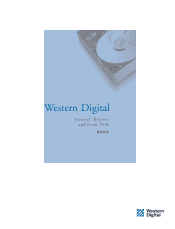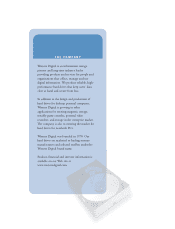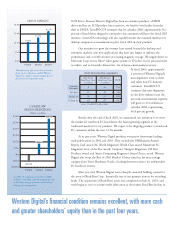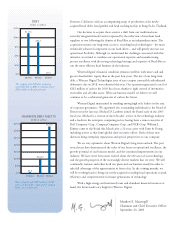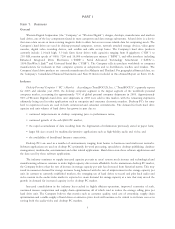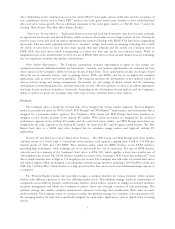Western Digital 2003 Annual Report Download - page 9
Download and view the complete annual report
Please find page 9 of the 2003 Western Digital annual report below. You can navigate through the pages in the report by either clicking on the pages listed below, or by using the keyword search tool below to find specific information within the annual report.PART I
Item 1. Business
General
Western Digital Corporation (the ""Company'' or ""Western Digital'') designs, develops, manufactures and markets
hard drives, one of the key components found in most computers and data storage subsystems. A hard drive is a device
that stores data on one or more rotating magnetic disks to allow fast access to non-volatile data for computing needs. The
Company's hard drives are used in desktop personal computers, servers, network attached storage devices, video game
consoles, digital video recording devices, and satellite and cable set-top boxes. The Company's hard drive products
currently include 1.0-inch high, 3.5-inch form factor drives with capacities ranging from 8 gigabytes (""GB'') to
250 GB, rotation speeds of 5400, 7200 and 10,000 revolutions per minute (""RPM''), and oÅer interfaces including
Enhanced Integrated Drive Electronics (""EIDE''), Serial Advanced Technology Attachment (""SATA''),
1394/FireWire/i.Link
TM
and Universal Serial Bus (""USB''). The Company sells its products worldwide to computer
manufacturers for inclusion in their computer systems or subsystems and to distributors, resellers and retailers. The
Company's hard drive products are currently manufactured in Malaysia and Thailand. For geographical Ñnancial data, see
the Company's Consolidated Financial Statements and Note 8 thereto included in this Annual Report on Form 10-K.
Industry
Desktop Personal Computer (""PC'') Market. According to TrendFOCUS, Inc. (""TrendFOCUS'') quarterly reports
for 2003 and calendar year 2002, the desktop computer segment is the largest segment of the worldwide personal
computer market, accounting for approximately 75% of global personal computer shipments in 2003. Approximately
90% of Western Digital's hard drive unit shipments in 2003 were sold to this market, with the remaining shipments
ultimately being used in other applications such as enterprise and consumer electronics markets. Desktop PC's for entry
level to experienced users are used in both commercial and consumer environments. The demand for both hard drive
capacity and unit volume of hard drives has grown in part due to:
‚ continued improvements in desktop computing price to performance ratios;
‚ continued growth of the sub-$600 PC market;
‚ the rapid accumulation of data resulting from the digitization of information previously stored in paper form;
‚ larger Ñle sizes created by multimedia-intensive applications such as high-Ñdelity audio and video; and
‚ the availability of broadband Internet connectivity.
Desktop PC's are used in a number of environments, ranging from homes to businesses and multi-user networks.
Software applications are used on desktop PC's primarily for word processing, spreadsheet, desktop publishing, database
management, multimedia, entertainment and other related applications. Hard drives store these software applications and
the data used by these software applications.
The industry continues to supply increased capacity per unit as users' system needs increase and technological and
manufacturing advances continue to make higher capacity drives more aÅordable. In the mainstream desktop PC market,
the Company believes that the rate of increase in storage capacity per unit has decreased from historical norms. This may
result in consumer demand for storage increases being balanced with the rate of improvement in the storage capacity per
unit. In contrast to currently established markets, the emerging use of hard drives to record and play back audio and
video content in the audio-video market is expected to create demand for storage capacity at a rate that may exceed the
growth in demand for increased capacity in the desktop PC market.
Increased consolidation in the industry has resulted in highly eÇcient operations, improved economies of scale,
continued intense competition and supply chain optimization, all of which tend to reduce the average selling price per
hard drive unit. The Company believes that metrics such as customer quality, total cost of ownership, supply chain
optimization and a stable supply of hard drives at attractive price levels will continue to be critical to its future success in
serving both the audio-video and desktop PC markets.
3

